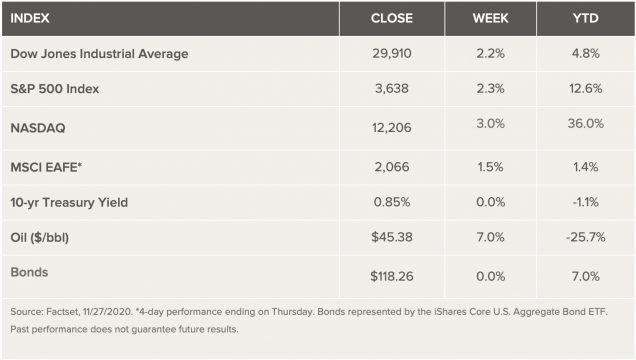

Stock Markets
This week has seen positive coronavirus-vaccine news, which helped propel the Dow Jones up more than 12% for the month, crossing the 30,000 mark for the first time, and on-track to have the best monthly gain since January 1987. The S&P 500 and Russell 2000 both posted fresh record highs as well. Trading was cut short last week, with Thanksgiving Thursday off and the equity markets closing early on Friday. Economic data releases were light, putting the emphasis on the high-wire act investors are walking between positive vaccine news and rapidly climbing cases and hospitalizations. Analysts think the longer-term outlook remains positive for stocks, but investors should expect spurts of volatility as we turn the page on 2020.
US Economy
“Dow 30,000” has a nice ring to it, but the more important question is: What does this number mean for investors? The underlying factors that have gotten the market to this level are more significant than the number itself. Nevertheless, reaching the 30K mark offers us an opportunity to reflect on the Dow’s milestones: Dow 30,000 is no more significant than 29,928 or 30,169 in the bigger picture. The Dow first crossed the 10,000 level in 1999 to substantial fanfare but proceeded to cross above and below that threshold numerous times in the following years. It last touched 10,000 in 2010. The 25,000 level has been crossed dozens of times since it was first reached in 2018, including as recently as this June. Market index levels can serve as historical measuring sticks, but don’t, in analysts’ view, have particular bearing on the market’s path ahead.
Metals and Mining
The gold price continued to tumble lower this week, dragged down by more positive COVID-19 vaccine news. The optimism around the latest vaccination announcements translated into economic rebound hopes, which weighed on safe haven demand. The yellow metal fell as low as US$1,776.59 per ounce on Friday after dropping 1 percent since Thursday. It hasn’t slipped below US$1,800 since July. Silver also faced headwinds during the last full week of the month, shedding US$2 by week’s end. Speaking about gold’s descent, Peter Grandich of Peter Grandich & Company reminded investors to look at big picture drivers such as continued currency debasement. On Friday, gold was priced at US$1,783.25. Silver’s correlation to gold drove the white metal lower this week as well. Renewed economic optimism wasn’t enough to push silver’s industrial side higher. Starting the period at US$24.05 per ounce, silver trended lower for the rest of the week, bottoming out at US$22.41 when markets opened on Friday. The 6 percent decline was the sharpest decrease silver has experienced since September. On Friday, silver was valued at US$22.70. As gold and silver faced volatility, platinum and palladium were able to edge out small gains. Platinum slipped briefly mid-week but recovered, ending the period slightly higher than Monday. Palladium faced a similar trajectory, shedding value mid-week and then rallying back. By Friday morning, platinum was trading for US$960 per ounce, while palladium was selling for US$2,269 per ounce.
The base metals displayed a mixed performance for the final week of November. Lead pulled off a 2 percent uptick for the best performance of the week. It was followed by copper, which had edged 1.9 percent higher by week’s end. Lead has steadily moved higher since early November, adding 14 percent to its value since the beginning of the month. On Friday morning, lead was priced at US$2,031 per tonne. Copper followed a similar path, save for some volatility experienced mid-month. The red metal has climbed 9.5 percent since November 1, motivated by economic growth in key countries. Prices could be further helped by a 4 percent year-on-year decline in mine supply forecast by Refinitv. By Thursday, copper prices breached US$7,500 per tonne for the first time since 2013. Copper was selling for US$7,511 Friday. Despite issues with mine supply earlier in the month, zinc prices traded sideways this week. Starting the period at US$2,756 per tonne, the metal dipped to US$2,727 on Wednesday. By Thursday, prices had crept higher, holding at US$2,754.50 into Friday. Nickel also benefited from a rally in base metals prices, but that could be short-lived, according to another Fastmarkets report.
Energy and Oil
Oil prices have held on to recent gains despite Covid-19 headwinds. Investors are growing increasingly optimistic and looking beyond the immediate crisis. “It’s a total change of vibe,” Robert Yawger, director of the futures division at Mizuho Securities USA, told the WSJ. “Everything is much more positive now.” OPEC+ is now leaning towards a three-month extension, although not every member is on the same page. Oil prices are holding firm on expectations that the group avoids letting the production cuts ease as scheduled in January, and instead pushes that off until the end of the first quarter at least. The leaders of the OPEC+ pact, Saudi Arabia and Russia, have requested an informal meeting of the Joint Ministerial Monitoring Committee (JMMC) to be held on Saturday, before the alliance’s formal meetings on November 30 and December 1 to decide whether to extend the current level of oil production cuts. Natural gas spot prices fell at most locations this week. The Henry Hub spot price fell from $2.77 per million British thermal units (MMBtu) last week to $2.36/MMBtu this week. At the New York Mercantile Exchange (NYMEX), the price of the December 2020 contract decreased 32¢, from $3.031/MMBtu last week to $2.712/MMBtu this week. The price of the 12-month strip averaging December 2020 through November 2021 futures contracts declined 21¢/MMBtu to $2.779/MMBtu.
World Markets
European shares rose for a fourth consecutive week, fueled by positive vaccine developments, fading U.S. election uncertainties, and expectations that the U.S. Congress may compromise on a smaller economic stimulus. However, the advance lost steam after the UK and Germany extended coronavirus restrictions and vaccine euphoria waned. In local currency terms, the pan-European STOXX Europe 600 Index ended the week 0.93% higher, while Germany’s DAX Index advanced 1.51%, France’s CAC 40 rose 1.86%, and Italy’s FTSE MIB added 2.92%. The UK’s FTSE 100 Index was little changed.
Core eurozone bond yields held firm overall despite a mixed week. Germany’s 10-year bund yield initially rose on more positive vaccine news. However, dovish messaging from the European Central Bank’s Philip Lane ahead of the European Central Bank’s (ECB) policy meeting next week reaffirmed market expectations for more stimulus, dragging yields back down to Monday’s levels. This dovishness pushed peripheral bond yields lower overall, with Portugal’s 10-year yield falling into negative territory. UK gilt yields also fell. Lingering Brexit worries and renewed concerns over economic growth prospects drove the decline, outweighing earlier increases in sentiment supported by vaccination progress.
Chinese stocks rose for the week as solid economic data outweighed concerns about rising defaults among domestic bond issuers. The blue chip CSI 300 Index added 0.8% while the Shanghai Composite Index gained 0.9% for the week, according to Reuters. In fixed income markets, the yield on the sovereign 10-year bond ended the week roughly unchanged. In currency trading, the yuan ended broadly flat against the U.S. dollar. A recent uptick in defaults in China’s high yield bond market has raised expectations that Beijing will focus on corporate sector deleveraging in the near term, as opposed to further stimulating the economy.
The Week Ahead
Economic series being released this week include pending home sales, Manufacturing PMI, and the unemployment rate.
Key Topics to Watch
- Chicago PMI
- Pending home sales index
- Markit manufacturing PMI
- ISM manufacturing index
- Construction spending
- Motor vehicle sales (SAAR)
- ADP employment report
- Beige Book
- Initial jobless claims (regular state program, SA)
- Initial jobless claims (total, NSA)
- Continuing jobless claims (regular state program)
- Continuing jobless claims (total, NSA)
- Markit services PMI
- ISM services index
- Nonfarm payrolls
- Unemployment rate
- Average hourly earnings
- Trade deficit
- Factory orders
Market Summary
